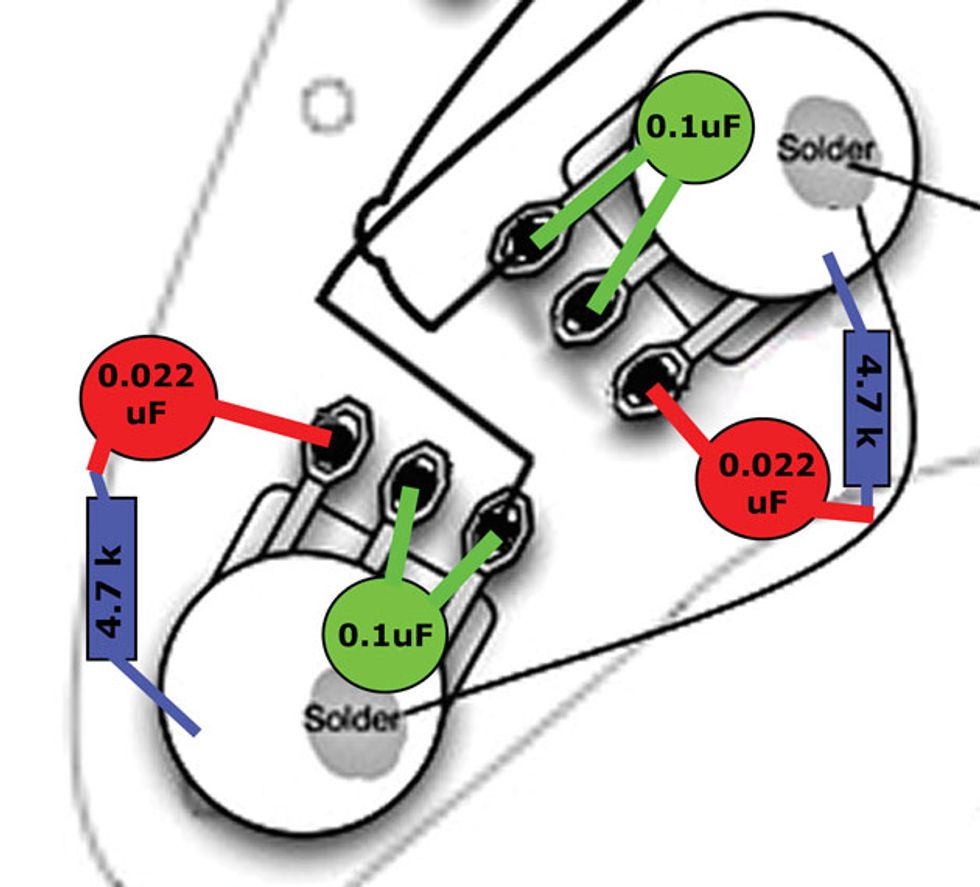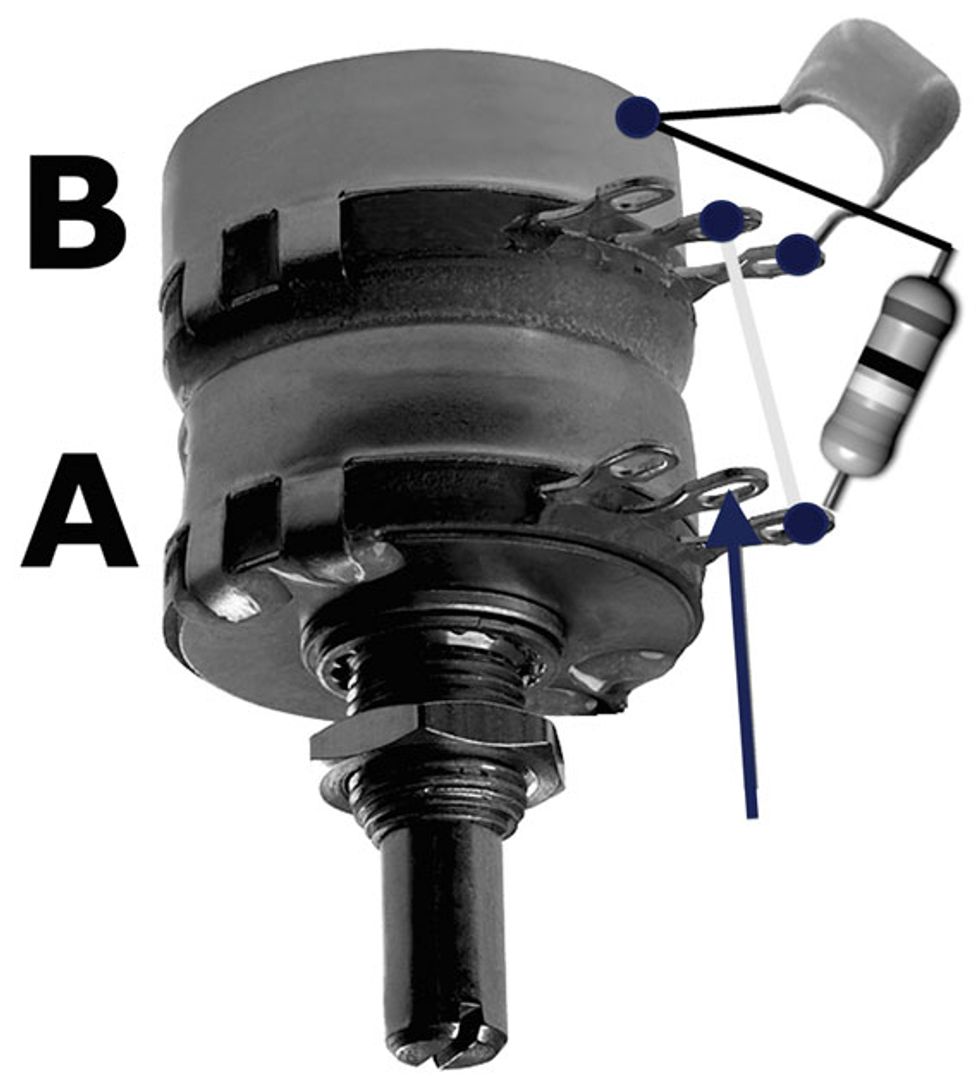Fig.1 — A pair of pots configured with the Greasebucket circuit. The same values are used for either guitar or bass.
Wiring diagram courtesy of Seymour Duncan (seymourduncan.com)
In recent columns we’ve been exploring passive tone systems—how they work, what they do, and what they don’t do. Now we’re about to challenge some basic misconceptions many bassists have as a result of reading what could be described as marketing jargon.
Let’s recap: We’ve learned that a passive circuit can only reduce parts of the tonal spectrum and not add to it. Still, some descriptions suggest otherwise. For example, to describe their popular passive Greasebucket circuit, Fender states that it “rolls off highs without adding bass.” This implies that one of the circuit’s special features is that it doesn’t add bass, while other passive circuits do. The fact is, the others don’t either.
Using words to describe tone is always tricky, and if we encounter a statement like “rolls off highs without adding bass,” we need to learn how to decode its meaning. When we use a passive tone control to roll off treble frequencies, the midrange and bass remain unaffected, but they become more prominent in the resulting mix as the highs disappear. We may perceive the signal as sounding deeper, but in no way does it have more bass than before.
What does the Greasebucket circuit (Fig. 1) offer that sets it apart from a standard passive treble-cut control? It’s basically a combination of a variable low-pass filter—our typical tone pot—and a high-pass filter that cuts the lows. So if we were to rewrite that previous phrase to say the circuit cuts everything but the mids, we’d have a far more accurate description of what’s going on.
Our guitar colleagues use the Greasebucket circuit to eliminate muddiness in a distorted sound. But because bassists prowl the lower frequencies, we’re more likely to prefer a separate control for the bass range instead of having a combined cut on both ends. Much like the switchable bass/treble cut we investigated in “Exploring Passive Tone Controls,” there are simple solutions for adjusting these ranges separately. That said, this Fender circuit with its integrated operation has its fans among low-enders.
The Greasebucket was introduced in 2005, and it’s still found in today’s Fender American Special Jazz Bass. The circuit has a somewhat similar ancestor: Fender’s TBX tone control, which stands for Treble Bass Expander. The passive TBX is installed on the Duff McKagan Precision Bass, and it’s also available in kit form to replace a standard treble-cut filter.
Once again, “expand” makes it sound like the circuit would add something, but like the Greasebucket, it doesn’t. Here’s how Fender describes the TBX: “This detented, stacked 250k/1 Meg control enhances your tonal palette without the use of a battery. From 0 to 5, the TBX is your standard tone control, but once you pass 5 you start to decrease the resistance, which allows more bass, treble, presence and output to flow to your amp.”
Despite the words “more treble, bass, presence,” the TBX simply works as a treble cut in one direction and a bass cut in the other. Of course, Fender is not alone in trying to depict passive circuits this way, but as long as you keep in mind that adding frequencies is impossible with such systems, it’s easy to learn how to interpret these statements.
Photo 1 — Fender’s TBX circuit comes in two versions—one for guitar, the other for bass. The latter uses a bigger capacitor, which results in a smaller low-end cutoff. Diagram courtesy of singlecoil.com
The TBX incorporates a stacked double pot (Photo 1). The electronic values of its components have changed over the years, but the principle has remained the same. Currently the stacked 250k/1M pot has a center detent with a “no-load” position in the middle, and the circuit includes an 82k-ohm resistor and a .022 µF or .033 µF capacitor for the guitar or bass version, respectively.
As usual, the cap determines the cutoff frequency, while the resistor prevents the bass side from going to absolute zero. The stock values are known to work well for bass, but as always, it’s easy and fun to experiment with others. Because the TBX is a passive device, your particular pickups affect how the circuit behaves, so there’s plenty of opportunity to be creative and fine-tune a TBX control to your instrument.









![Rig Rundown: AFI [2025]](https://www.premierguitar.com/media-library/youtube.jpg?id=62064741&width=1245&height=700&quality=70&coordinates=0%2C0%2C0%2C0)












 Shop Scott's Rig
Shop Scott's Rig


![Rig Rundown: Russian Circles’ Mike Sullivan [2025]](https://www.premierguitar.com/media-library/youtube.jpg?id=62303631&width=1245&height=700&quality=70&coordinates=0%2C0%2C0%2C0)












































